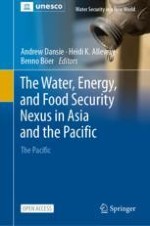4.1 Introduction
Category and United/Country | Kiribati | Solomon Islands | Tuvalu | Samoa | Tonga | Papua New Guinea | Vanuatu |
|---|---|---|---|---|---|---|---|
Nutrition and demographic measures | |||||||
Stunting ratea (% under 5 years) | 15.2 | 31.6 | 10 | 4.9 | 8.1 | 49.5 | 28.5 |
Wasting ratea (% under 5 years) | 3.7 | 8.5 | 3.3 | 3.9 | 5.2 | 14.1 | 4.4 |
Obesitya (% male/female) | 42/50 | 18/27 | 47/56 | 40/55 | 41/54 | 17/26 | 20/30 |
Population distributionb (% rural/urban) | 46/54 | 76/24 | 38/62 | 82/18 | 77/23 | 87/13 | 75/25 |
Production | |||||||
Agricultural landc (% land area) | 42 | 3.9 | 60 | 12.4 | 45.8 | 25.6 | 15.3 |
Agriculture and fisheries, value addedb (% of GDP) | 30.8 | 35 | 16.5 | 9.8 | 17.2 | 17.7 | 25.8 |
Per capita food production variability (2015)d ($ per person constant 2004–2006) | 24.1 | 2 | 1.3 | 4 | 9.8 | 1.9 | 16.8 |
Value of food imports over total merchandise exportsd (3-year average) (2015–2017) (Percent) | 261 | 22 | 14 | 158 | 231 | 8 | 123 |
Emissions (CO2 equivalent) from land-based agriculture (2018) In gigagrams (1,000 tonnes) | 8.45 | 65.55 | 5.95 | 181.52 | 68.81 | 4,738.58 | 434.06 |
Top staple foods (Note that most rice is imported into PNG and PICT countries) | Banana, coconut, taro, breadfruitc | Sweet potato, coconut, rice, cassava, banana taro, yame | Swamp taro, coconut, banana, breadfruit, taro, cassava, sweet potatof | Taro, rice, coconut, banana, wheat-based foodsg | Cassava, coconut, sweet potato, yam, taro, bananac | Sweet potato, rice, banana, coconut, yam, cassava, Colocasia taro, Xanthosomah taro, sago | Taro, coconut, rice, banana, yam, cassava, sweet potatoi |
Consumption | |||||||
Average national energy consumption (kcal/capita/day) | 2,760j | 2,640k | 2,800l | 2,800m | 2,900n | 2,629o | 3,056p |
Proportion of energy consumed as: | |||||||
Protein (%, note WHO recommends 10–15%) | 13 | 11 | 14 | 11 | 14 | 8o | 12p |
Fats (%, note WHO recommends 15–30%) | 17 | 22 | 29 | 34 | 27 | No data | 22p |
Carbohydrates (%, note WHO recommends 55–75%) | 70 | 67 | 57 | 55 | 59 | No data | No data |
Fruits and vegetables consumed (grams/capita/day, WHO recommends 400 g) | 130 | 182 | 102 | 300 | 260 | No data | No data |
Food consumed from local (in-country) production, contribution to total dietary energy consumed (%) | 12 | 52 | 25 | 30 | 19 | No data | No data |
Contribution of food groups and food products to average dietary energy consumptionq | |||||||
Cereals and their products (%) | 44 | 24 | 34 | 29 | 22 | 26r | |
Meat and meat products (%) | >5 | >5 | 8 | 10 | 13 | 11 | |
Fish, shellfish, and their products (%) | 8 | 7 | 7 | >5 | >5 | > 5 | |
Sweets, sugar, and syrups (%) | 17 | 5 | 17 | 7 | 5 | 6 | |
Pulses, seeds, and nuts (%) | 5 | 19 | No data | No data | No data | No data | |
Oil crops (%) | No data | No data | 19 | 18 | No data | 6 | |
Roots, tubers, plantains, and their products | >5 | 36 | >5 | 10 | 29 | No data | |
Melanesia (Fiji, Papua New Guinea, Solomon Islands, Vanuatu) (%) | Polynesia (Samoa, Tonga, Tuvalu) (%) | Micronesia (Kiribati, Marshal Islands, Federal States of Micronesia, Nauru, Palau) (%) | Global average (%) | |
|---|---|---|---|---|
Women of reproductive age with anemia | 35.9 | 27.9 | 25.1 | 32.8 |
Stunting, children under 5-years | 49.5 | 4.9 | Data not available | 21.9 |
Wasting, children under 5-years | 13.3 | 3.9 | Data not available | 7.3 |
Overweight in children under 5-years | 13.7 | 5.3 | Data not available | 5.9 |
Men with diabetes | 15.3 | 22.4 | 21.7 | 9 |
Women with diabetes | 14.8 | 26.4 | 22.8 | 7.9 |
Men with obesity | 17.5 | 54.9 | 43.6 | 10.5 |
Women with obesity | 26.8 | 40.7 | 53.1 | 14.7 |
